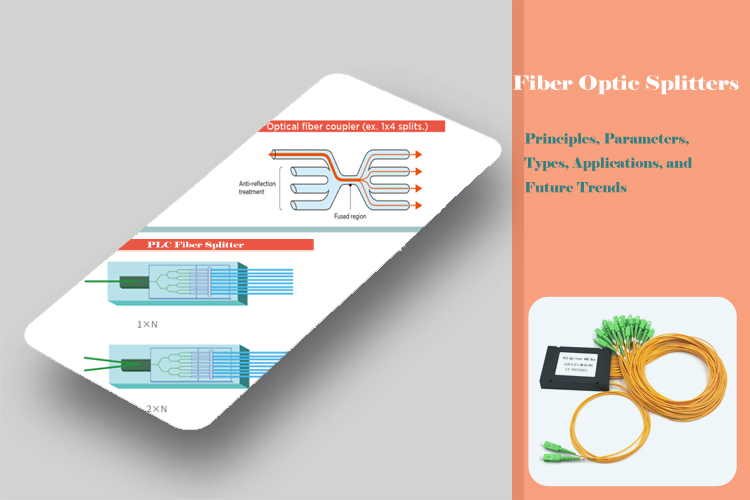By goodvin | 01 August 2023 | 0 Comments
Understanding Fiber Optic Splitters: Principles, Parameters, Types, Applications, and Future Trends
Understanding Fiber Optic Splitters: Principles, Parameters, Types, Applications, and Future Trends
1. Introduction
Fiber optic splitters are integral components in the world of optical networks. They are devices that split an incident light beam into several light beams at certain splitting ratios. The role of these splitters in optical networks is crucial as they allow a single optical signal to be shared among many users, thereby enhancing the efficiency and capacity of the network. The commonly seen Fiber Optic Splitters include PLC Fiber Optic Splitter and FBT Splitter.

2. Working Principle
The working principle of fiber optic splitters is based on the 1:N splitting principle. This principle allows a single input light beam to be split into N output light beams. The splitting can be achieved through two main methods: parallel beam splitting and beam divergence splitting.
Parallel beam splitting involves splitting the input beam into several parallel output beams. On the other hand, beam divergence splitting involves splitting the input beam into several diverging output beams. The choice between these two methods depends on the specific requirements of the optical network.
3. Main Parameters
The performance of a fiber optic splitter is determined by several parameters. These include the splitting ratio, insertion loss, uniformity, and isolation.
The splitting ratio refers to the ratio of the power of the output light beams to the power of the input light beam. Insertion loss is the loss of signal power resulting from the insertion of a device in a transmission line or optical fiber. Uniformity is the degree to which the power of the output light beams is equal. Isolation is the ability of the splitter to prevent unwanted signals or reflections from traveling back to the input.
4. Common Types
There are several types of fiber optic splitters, each with its unique characteristics and applications. These include the planar waveguide splitter, tree-like splitter, star coupler, and Wavelength Division Multiplexing (WDM) splitter.
Planar waveguide splitters are compact and offer low insertion loss. Tree-like splitters are known for their high splitting ratios. Star couplers are used for their uniform splitting, while WDM splitters are used to split light beams of different wavelengths.
5. Application Areas
Fiber optic splitters are used in various areas, including active optical networks, passive optical networks, FTTX access networks, and measurement systems.
In active optical networks, they are used to distribute signals to multiple users. In passive optical networks, they are used to split the signal into multiple paths. In FTTX access networks, they are used to deliver services such as internet, television, and telephone. In measurement systems, they are used to measure parameters such as power and wavelength.
6. Development Trends
The field of fiber optic splitters is continuously evolving, with trends pointing towards large-scale splitting, wide wavelength range, and integration.
Large-scale splitting involves splitting a single input beam into a large number of output beams, thereby increasing the capacity of the network. Wide wavelength range involves splitting light beams of a wide range of wavelengths, thereby increasing the versatility of the network. Integration involves integrating the splitter with other components of the network, thereby increasing the efficiency of the network.
7. Summary
In conclusion, fiber optic splitters play a crucial role in optical networks. They operate based on the 1:N splitting principle and are characterized by parameters such as splitting ratio, insertion loss, uniformity, and isolation. There are various types of splitters, each with its unique applications. The field is continuously evolving, with trends pointing towards large-scale splitting, wide wavelength range, and integration.
FAQs
1. What is the role of fiber optic splitters in optical networks?
Fiber optic splitters play a crucial role in optical networks. They allow a single optical signal to be shared among many users, thereby enhancing the efficiency and capacity of the network.
2. What is the difference between parallel beam splitting and beam divergence splitting?
Parallel beam splitting involves splitting the input beam into several parallel output beams. On the other hand, beam divergence splitting involves splitting the input beam into several diverging output beams. The choice between these two methods depends on the specific requirements of the optical network.
3. What are the main parameters that determine the performance of a fiber optic splitter?
The performance of a fiber optic splitter is determined by several parameters. These include the splitting ratio, insertion loss, uniformity, and isolation.
4. What are the common types of fiber optic splitters?
The common types of fiber optic splitters include the planar waveguide splitter, tree-like splitter, star coupler, and Wavelength Division Multiplexing (WDM) splitter.
5. What are the current development trends in the field of fiber optic splitters?
The current trends in the field of fiber optic splitters point towards large-scale splitting, wide wavelength range, and integration.
Keywords: Fiber optic splitters, optical networks, 1:N splitting principle, parallel beam splitting, beam divergence splitting, splitting ratio, insertion loss, uniformity, isolation, planar waveguide splitter, tree-like splitter, star coupler, WDM splitter, active optical networks, passive optical networks, FTTX access networks, measurement systems, large-scale splitting, wide wavelength range, integration.
Leave a Reply
Your email address will not be published.Required fields are marked. *
POPULAR BLOG
- The Detailed Explanation of Optical CWDM
- The Application and Key Role of Optical Switch in Optical Communication Network
- Guide to the Construction of Optical Fiber Cable Factories
- The Future of Fiber Optic Access Networks: An Expert Perspective
- Market Analysis of Fiber Optic Testing Equipment: Key Trends and Insights